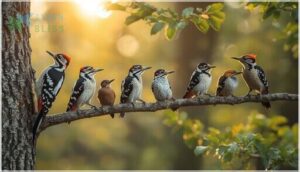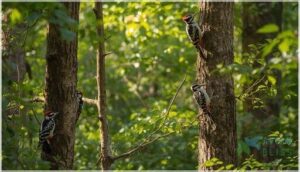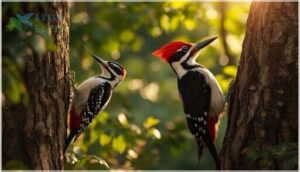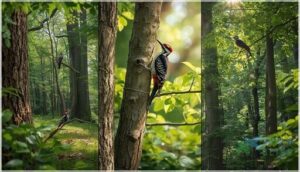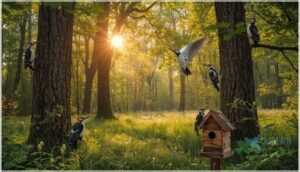This site is supported by our readers. We may earn a commission, at no cost to you, if you purchase through links.
The distinctive drumming echoing through Indiana’s woodlands isn’t random percussion—it’s a territorial announcement from one of the state’s seven resident woodpecker species. These specialized birds hammer away at tree bark thousands of times daily, yet their skulls absorb impacts that would cause concussions in most animals.
From the sparrow-sized Downy Woodpecker tapping at your backyard feeder to the crow-sized Pileated Woodpecker carving rectangular holes in dead oaks, Indiana’s woodpeckers showcase striking adaptations for life clinging to vertical surfaces.
Understanding their field marks, preferred habitats, and seasonal behaviors transforms a casual glimpse of black-and-white plumage into confident species identification.
Table Of Contents
- Key Takeaways
- Common Woodpecker Species in Indiana
- Identifying Indiana Woodpeckers
- Woodpecker Habitats Across Indiana
- Woodpecker Diets and Feeding Habits
- Conservation and Viewing Tips in Indiana
- Frequently Asked Questions (FAQs)
- What is the most common woodpecker in Indiana?
- How do you tell the difference between a Downy Woodpecker and a hairy woodpecker?
- Is it good to have woodpeckers in your yard?
- What do female woodpeckers look like?
- What sounds do Indiana woodpeckers make?
- Do Indiana woodpeckers migrate during winter months?
- How long do woodpeckers live in Indiana?
- When is woodpecker mating season in Indiana?
- Can Indiana woodpeckers damage houses and buildings?
- How many woodpecker species live in Indiana?
- Conclusion
Key Takeaways
- Indiana is home to seven woodpecker species, each with unique markings, habitats, and seasonal behaviors that help you tell them apart.
- Leaving dead trees standing and planting native trees in yards are the best ways to support woodpecker populations statewide.
- Most Indiana woodpeckers stay year-round, but the Yellow-bellied Sapsucker is the only true migratory species, visiting during winter.
- Get better at identifying woodpeckers by learning their calls, feeding habits, and subtle differences in size, bill shape, and color patterns.
Common Woodpecker Species in Indiana
Indiana is home to quite a variety of woodpecker species, each with its own quirks and favorite hangouts. Getting to know a few of the most common ones can make spotting them much easier.
Let’s take a closer look at the ones you’re most likely to see around here.
Downy Woodpecker
When you think of Indiana woodpeckers, the Downy Woodpecker likely comes to mind. This small, black-and-white Indiana bird species thrives in both rural forests and backyards, showing impressive Urban Adaptations. Look for them at suet feeders—Backyard Feeding is common—and spot their tiny bills.
Woodpeckers like the Downy thrive in areas with mature forest habitats. Population Stability remains strong due to adaptable Nesting Habits. Identifying Females is tricky, as they lack the male’s red nape.
Hairy Woodpecker
If you spot a woodpecker with a longer, chisel-like bill and strong black-and-white striping, you’ve likely found the Hairy Woodpecker.
Active in both Indiana forests and backyards, they depend on large trees for nesting and foraging. Habitat loss threatens local stability, but thanks to year-round presence and flexible feeding ecology, their population trends remain steady. They’re known to consume large numbers of wood-boring insects.
Northern Flicker
The Northern Flicker stands out among Woodpecker Species in Indiana for its spotted belly, black bib, and knack for Ant Consumption. If you’re into Bird Watching in Indiana, watch for their long Tongue Extension probing the ground. Flicker Decline links to Nest Competition and Urban Mortality, but you can still find them by:
- Checking forest edges
- Listening for “wicka” calls
- Scanning open parks
Pileated Woodpecker
Look for the fiery red crest and hefty bill—that’s the Pileated Woodpecker, Indiana’s largest woodpecker species. Their powerful drumming echoes deep through mature forests, where they nest in old trees and feast on carpenter ants.
If you’re passionate about Bird Watching in Indiana, note their loyalty to territory and stable population trends tied closely to forest dependence and dietary habits.
Red-bellied Woodpecker
Plenty of Indiana backyards play host to the Red-bellied Woodpecker, a hallmark of suburban expansion and population growth. Identify them using these cues:
- Zebra-barred backs with pale faces
- Males’ bold red caps
- Chisel-shaped bills
- Rolling, distinctive vocalizations
- Diverse dietary adaptations—nuts, fruit, and insects
Master these identification nuances for your next bird identification guide!
Red-headed Woodpecker
Among Indiana woodpeckers, the Red-headed Woodpecker stands out for its flashy crimson cap and tuxedo-like plumage. This species, with a declining population, requires thoughtful habitat management.
You’ll often see its clever feeding habits—catching insects in midair or caching acorns.
For woodpecker identification and birdwatching in Indiana, knowing their breeding behavior and conservation status makes encounters especially rewarding.
Yellow-bellied Sapsucker
With their precise Sap-Well Ecology and distinctive Migratory Patterns, the Yellowbellied Sapsucker sets itself apart among Indiana woodpeckers. You’ll spot this unique species when winter rolls around, drilling neat rows in tree bark for sap and insects—a striking example of Dietary Adaptations.
Understanding their Nesting Habits and Conservation Status deepens your Bird Identification Guide skills while exploring Indiana.
Other Notable Species
Not every woodpecker sighting in Indiana fits a neat checklist. If you keep your eyes sharp, you might hear about Black-backed sightings or rare Three-toed occurrences—both true northern wanderers.
The legendary Ivory-billed status remains a ghost story, while accidental Lewiss records and unique hybrid observations add fresh chapters to the diverse types of woodpecker species you can spot.
Identifying Indiana Woodpeckers
Curious which woodpecker just landed on your tree? You don’t need to be an expert to spot the clues.
Here’s what to look for when telling Indiana woodpeckers apart.
Size and Shape Differences
Ever noticed how size and shape can be the secret to woodpecker species identification? Watch for these clues:
- Bill size varies—from downy’s short to hairy’s long chisel
- Body proportions shift from compact to sturdy
- Tail feathers may be all white or marked
- Wingspan range can surprise you
- Weight variation can be subtle, yet telling
Get curious; details reveal everything!
Color Patterns and Markings
What’s the first thing you notice about a woodpecker? Usually, it’s the bold color pattern—think the crisp black-and-white stripes on a Downy Woodpecker or the dazzling red crown of a Red-headed Woodpecker.
Plumage identification goes beyond color: look for malar stripes, camouflage patterns, and juvenile markings. These subtle differences help with woodpecker species identification and reveal regional variations too.
Bill Shape and Length
After soaking in those bold color patterns, take a closer look at each woodpecker’s bill shape and length. These aren’t just cosmetic quirks—they fuel everything from drilling mechanics to foraging adaptations.
Downy Woodpeckers sport short, dainty bills for surface gleaning, while Pileated Woodpeckers wield long, sturdy chisels, each reflecting evolutionary pressures and unique feeding strategies you’ll spot in the field.
Unique Calls and Drumming
Now, let’s tune in to each species’ language—distinct calls and drumming patterns. During spring, woodpeckers ramp up drumming communication for territories and mates, each rhythm or call acting like a signature.
Pileated Woodpeckers hit rich “cuk-cuk-cuk,” while Downy’s drumming calls are sharper, quick. These behavioral clues enable woodpecker identification and deepen your connection to their song-filled world.
Flight and Foraging Behaviors
After you recognize their signature calls, watch for unique flight patterns—undulating, direct, or gliding—and see how each woodpecker works its chosen foraging substrates.
Downy Woodpeckers zigzag through treetops, while Northern Flickers dig ants from the ground. Paying attention to temporal feeding, diet diversity, and habitat use sharpens your identification skills with every sighting.
Woodpecker Habitats Across Indiana
Woodpeckers turn up in all sorts of places across Indiana, from quiet woods to your neighborhood park. Each type has its own favorite hangouts.
Let’s take a closer look at where you’re most likely to spot them.
Deciduous Forests and Woodlands
Curious how forest habitat types shape woodpecker life in Indiana? Deciduous forests and woodlands, with their oak and maple mix, provide shelter, nesting cavity fidelity, and year-round food sources.
Changing seasons trigger population distribution shifts and seasonal diet changes.
Smart habitat management impacts everything—when you protect dead trees and forest edges, you help keep Indiana’s woodpeckers thriving.
Mature Forests and Dead Trees
Amid mature Indiana forests, snag abundance—those standing dead trees—steals the show. These ancient forests, rich in both age and structure, shape woodpecker habitat by offering safe nesting, reliable food, and supporting forest ecology.
Woodpeckers thrive here, thanks to diverse species preferences and the unique ecological benefits snags provide. Conservation efforts prioritize retaining snags to keep these essential residents around.
Urban Parks and Backyards
Right in your neighborhood, Indiana woodpeckers make themselves at home. Urban parks and backyards offer surprising diversity—Downy Woodpeckers lead the way, with Red-bellied populations up 55% statewide since 2003. Human impact adaptation shows clearly here.
- Suet feeders draw Downys and Red-bellieds during winter
- Mature trees and deadwood remain essential even in cities
- Northern Flickers forage on lawns for ants and beetles
- Citizen science through Christmas Bird Counts tracks these backyard birds effectively
Open Woods and Savannas
In Indiana’s open woodlands and savannas, you’ll find woodpeckers thriving where tree cover opens up. Red-headed Woodpeckers use edge habitats here, with occupancy rates reaching 76% in restored sites.
Snag importance can’t be overstated—standing dead trees provide essential nesting and foraging spots.
Savanna restoration efforts directly combat habitat fragmentation, boosting woodpecker populations within just 2–5 years. These transitional zones offer ideal identification opportunities year-round.
Seasonal Movements and Migration
Most woodpeckers you’ll spot in Indiana stick around all year, but the Yellow-bellied Sapsucker stands out as the state’s only truly migratory bird in this family. It treats southern Indiana as prime sapsucker wintering grounds from October through March.
Red-heads show partial migration—some leave, others stay.
Rare irruptive winter visitors like Black-backed Woodpeckers occasionally appear during beetle outbreaks, making migration timing unpredictable but exciting.
Woodpecker Diets and Feeding Habits
Woodpeckers in Indiana have fascinating eating habits that change with the seasons and vary between species. They’re not just about drilling into tree bark—these birds have developed clever ways to find food year-round.
Let’s look at how different woodpeckers feed and what they prefer to eat throughout the year.
Insect Foraging Techniques
You’ll find woodpeckers in Indiana using surprisingly diverse foraging techniques to snag their insect meals. Surface gleaning—quickly snatching beetles and ants from bark—accounts for nearly 79% of their feeding time.
Bark excavation digs deeper for hidden larvae, especially in winter. Some species even practice aerial capture, hawking flying insects midair, or ground foraging when carpenter ants emerge. Each method boosts foraging efficiency across seasons.
Use of Fruits, Nuts, and Seeds
Beyond insects, your backyard woodpeckers in Indiana turn to fruits, nuts, and seeds—especially when cold weather strikes. These seasonal food shifts reveal smart survival strategies and offer backyard feeding tips you can use year-round.
Here’s what woodpecker feeding habits include:
- Fruit preferences: Red-bellied and Red-headed Woodpeckers devour cherries, grapes, and berries during late summer and fall.
- Nut caching behavior: Species store acorns and beechnuts in bark crevices for winter survival.
- Seed foraging strategies: Downy and Hairy Woodpeckers favor sunflower seeds at feeders, supplementing their insect diets.
Sap Well Drilling Behavior
One Indiana woodpecker stands out for unusual behavior: the Yellow-bellied Sapsucker. You’ll spot their orderly rows of sap wells—tiny holes drilled into birch and maple trunks.
These wells aren’t just for sap; they trap insects, boosting the bird’s caloric intake by up to 60%. During spring migration, sapsuckers drill hundreds of wells per tree, revisiting them 25 times daily.
Sapsucker wells trap insects and boost caloric intake by 60%, with birds revisiting hundreds of wells up to 25 times daily
Seasonal Food Preferences
As seasons shift in Indiana, woodpeckers adjust what they eat. Spring sap consumption gives way to insect foraging shifts—Northern Flickers feast on ants while Pileated Woodpeckers hunt carpenter ants.
Come fall, seasonal diet diversity kicks in. You’ll see winter food caching behavior as Red-headed Woodpeckers stash acorns. Backyard feeder appeal grows strong when suet and sunflower seeds replace scarce wild foods.
Conservation and Viewing Tips in Indiana
Watching woodpeckers in Indiana is easier when you know where to look and how to support them. You can help protect these birds while improving your chances of spotting them in your own backyard.
Here’s what you need to know about conservation efforts, attracting woodpeckers, and contributing to their protection across the state.
Protecting Woodpecker Habitats
Across Indiana’s forests, you can make a real difference for woodpeckers. Forest management that leaves dead trees standing boosts nesting sites by over 25%. Urban initiatives preserving mature oaks help too—cities now report 30% higher woodpecker numbers.
Even with agricultural pressures claiming 64% of Indiana’s land, targeted ecosystem restoration and snag preservation reverse declines, protecting the wildlife habitat these birds desperately need.
Supporting Local Conservation Efforts
You can support woodpecker conservation by joining Indiana Audubon Society programs or volunteering with Amos Butler Audubon Society. Citizen science initiatives help track bird populations—your sightings matter.
Local organizations coordinate habitat restoration projects and education initiatives funded through State Wildlife Grants, which brought Indiana $963,000 in 2021. Pheasants Forever chapters keep fundraising dollars local, directly supporting wildlife conservation efforts and bird conservation in Indiana where Indiana wildlife needs it most.
Attracting Woodpeckers to Your Yard
You can transform your yard into a woodpecker haven with a few strategic additions. Suet feeder types attract over 75% more winter visitors, while native tree selection—especially oaks and maples—boosts foraging by 44%.
Try these proven methods:
- Install suet feeders and offer black oil sunflower seeds at bird feeders
- Preserve dead trees (snags) for nesting cavities
- Add water source placement with dripping features
- Maintain pesticide-free yards to protect insect prey
Backyard birding in Indiana succeeds when you mimic natural woodpecker habitats.
Responsible Birdwatching Practices
When you practice ethical observation, you protect woodpeckers and their habitat. Stay at least 30 meters away to minimize disturbance during birdwatching.
Follow legal compliance rules on Indiana public lands, especially during the March-May breeding season when seasonal awareness matters most. Skip playback calls that stress birds, and keep to marked trails for habitat respect.
These simple wildlife conservation steps make backyard birding better for everyone—including the birds you’re hoping to spot.
Citizen Science and Reporting Sightings
When you report woodpecker sightings to eBird, you join over 57,000 Indiana participants making real conservation impact. Your data contribution helps track bird species populations and guides habitat protection decisions.
Outreach efforts have made birdwatching accessible to all ages, and volunteer demographics show growing backyard birdwatching engagement.
Bird identification gets easier with practice, and your observations matter more than you’d think.
Frequently Asked Questions (FAQs)
What is the most common woodpecker in Indiana?
You might think Indiana’s biggest woodpecker would be most common, but the tiny Downy Woodpecker actually dominates—accounting for 32% of all state sightings and thriving in backyards, parks, and forests alike.
How do you tell the difference between a Downy Woodpecker and a hairy woodpecker?
You can spot the difference through size comparison and bill proportion. Downy Woodpeckers are smaller with shorter bills, while Hairy Woodpeckers are larger with bills nearly equal to their head length. Check for tail spots too.
Is it good to have woodpeckers in your yard?
Welcoming woodpeckers into your backyard is like inviting ecosystem engineers to keep things balanced. They offer birdwatching benefits, natural pest control, and help cavity nesting species thrive—though you’ll want to guard against property damage with smart habitat choices.
What do female woodpeckers look like?
Female woodpeckers usually show subtler color patterns, with less red on the head or nape and finer barring.
For accurate woodpecker identification and sexing techniques, watch for beak variations, malar stripe differences, and subtle shifts in female plumage.
What sounds do Indiana woodpeckers make?
You’ll hear Indiana woodpeckers drumming on trees, their Sound Function ranging from sharp, high-pitched beats by Downy Woodpeckers to deep resonant rhythms in large species.
Vocals vary—distinct “pik,” “churr,” or “wicka” calls aid Call Identification during Acoustic Monitoring.
Do Indiana woodpeckers migrate during winter months?
Imagine Indiana’s woodpeckers as neighbors—most stick around for winter, adapting to cold with clever foraging. Only the Yellow-bellied Sapsucker truly migrates, while Red-headed and Northern Flickers sometimes wander, proving avian migration is rarely just black and white.
How long do woodpeckers live in Indiana?
Woodpeckers in Indiana usually have an average lifespan of 2 to 12 years, depending on species. Maximum longevity can reach nearly 16 years, though urban impact and natural survival factors often affect their actual status and behavior locally.
When is woodpecker mating season in Indiana?
If mating season ran on dial-up, woodpeckers in Indiana would still be right on schedule: breeding behavior kicks off in late March, with peak mating rituals, nesting habits, incubation periods, and fledgling development from April through July.
Can Indiana woodpeckers damage houses and buildings?
Yes, Indiana woodpeckers can cause noticeable damage to houses, especially where habitat overlaps with backyards.
Buildings with cedar or synthetic siding face high damage frequency and repair costs, but deterrence strategies can reduce risks for vulnerable structures.
How many woodpecker species live in Indiana?
Indiana is home to seven woodpecker species, a number shaped by ongoing data collection methods and regional species variation.
Maintaining Species Count Accuracy can be tricky, as misidentification challenges and shifts in historical species presence often arise.
Conclusion
If Indiana’s forests thundered like a hundred drumlines, it would be the persistent calls and rhythmic strikes from the woodpeckers of Indiana echoing through the trees. By learning their clues—flecks of red, drumming patterns, or flight styles—you gain more than an identification skill; you step into their world for a moment.
Carry that practice into your next walk. You might spot a Downy Woodpecker or Pileated carving a story into the bark, one tap at a time.


